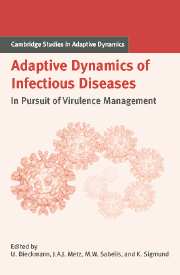Book contents
- Frontmatter
- Contents
- Contributing Authors
- List of Boxes
- Notational Standards
- 1 Introduction
- A Setting the Stage
- B Host Population Structure
- C Within-Host Interactions
- D Pathogen–Host Coevolution
- E Multilevel Selection
- Introduction to Part E
- 20 Weakened from Within: Intragenomic Conflict and Virulence
- 21 Ecology and Evolution of Chestnut Blight Fungus
- 22 Evolution of Exploitation and Defense in Tritrophic Interactions
- F Vaccines and Drugs
- G Perspectives for Virulence Management
- References
- Index
- International Institute for Applied Systems Analysis
21 - Ecology and Evolution of Chestnut Blight Fungus
Published online by Cambridge University Press: 15 January 2010
- Frontmatter
- Contents
- Contributing Authors
- List of Boxes
- Notational Standards
- 1 Introduction
- A Setting the Stage
- B Host Population Structure
- C Within-Host Interactions
- D Pathogen–Host Coevolution
- E Multilevel Selection
- Introduction to Part E
- 20 Weakened from Within: Intragenomic Conflict and Virulence
- 21 Ecology and Evolution of Chestnut Blight Fungus
- 22 Evolution of Exploitation and Defense in Tritrophic Interactions
- F Vaccines and Drugs
- G Perspectives for Virulence Management
- References
- Index
- International Institute for Applied Systems Analysis
Summary
Introduction
There is a vast body of literature on the ecology and evolution of infectious diseases. Most of this literature, however, focuses on single species of hosts and pathogens, and, more specifically, on the dynamics of pathogen transmission among hosts, within-host dynamics, the evolution of host resistance, and the evolution of pathogen virulence (Levin and Bull 1996). It is often overlooked that in many natural populations, diseases exist within a complicated ecological community involving various forms of competing pathogens, pathogens of pathogens, etc. Hyperparasitism, for example, is an interaction that involves a pathogen that is in turn infected with a parasite of its own – that is, a hyperparasite. Hyperparasites may have deleterious effects on pathogens and, thereby, affect other species down the trophic chain in a manner similar to the top-down effects that predators can have on communities (Hairston et al. 1960; Fretwell 1977; Oksanen et al. 1981; Powers 1992; see Holt and Hochberg 1998).
Hyperparasitism is widespread in natural populations, and it is important in management situations. Hyperparasitoids, for example, frequently occur in arthropod food chains, often undermining efforts to employ parasitoids as biological control agents (Beddington and Hammond 1977; May and Hassell 1981). Many of the numerous examples that involve hyperparasitism of fungal pathogens of plants (Hollings 1982; Buck 1986) have attracted attention as potential agents of biological control (Nuss 1992).
- Type
- Chapter
- Information
- Adaptive Dynamics of Infectious DiseasesIn Pursuit of Virulence Management, pp. 286 - 296Publisher: Cambridge University PressPrint publication year: 2002
- 3
- Cited by



